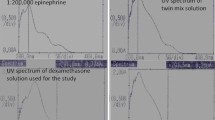Abstract
Introduction
A prospective randomized double-blind study was conducted to assess the latency and duration of pterygomandibular nerve block with a mixture of 1.8 ml 2 % lignocaine with 1:200,000 epinephrine and 1 ml of 4 mg dexamethasone and its impact on postoperative sequelae of surgical extraction of impacted mandibular third molars.
Material and methods
The study was conducted as a prospective randomized double-blind clinical trial on 20 patients with bilateral impaction of mandibular third molars. A total of 40 interventions were included for the study, 20 with 2 % lignocaine with 1:200,000 epinephrine (study group C, control) and 20 with the twin-mix (study group T, twin-mix), with a gap of 1 month between two interventions in a single patient. After injection of the anesthetic solution, the time to anesthetic effect, duration of anesthesia, and the need to re-anesthetize the surgical site were recorded. A 10-point visual analog scale (VAS) was used to assess the overall pain intensity while injecting the study drug, during surgery, and in the postoperative period. pH of the test anesthetic solutions was also determined using a pH meter.
Results
Twin-mix was found to be more basic than 2 % lignocaine with 1:200,000 epinephrine. Mean VAS value for the pain/sting on local anesthetic injection/block was less in study group T. Time of onset of the local anesthetic was significantly less for the study group T, 51 ± 17.5 s when compared with patients in study group C (P less than 0.0001). The duration of soft tissue anesthesia was longer for all the patients in the study group T. On comparative evaluation between study group C and study group T, patients in the control group had more sever swelling and reduction in mouth opening in the postoperative period.
Discussion
The addition of dexamethasone to lignocaine and its administration as an intra-space injection significantly shortens the latency and prolongs the duration of the soft tissue anesthesia, with improved quality of life in the postoperative period after surgical extraction of mandibular third molars.


Similar content being viewed by others
References
Neupert EA 3rd, Lee JW, Philput CB, Gordon JR (1992) Evaluation of dexamethasone for reduction of postsurgical sequelae of third molar removal. J Oral Maxillofac Surg 50(11):1177–1182
Tiwana PS, Foy SP, Shugars DA, Marciani RD, Conrad SM, Phillips C, White RP (2005) The impact of intravenous corticosteroids with third molar surgery in patients at high risk for delayed health-related quality of life and clinical recovery. J Oral Maxillofac Surg 63(1):55–62
Alexander RE, Throndson RR (2000) A review of perioperative corticosteroid use in dentoalveolar surgery. Oral Surg Oral Med Oral Pathol Oral Radiol Endod 90(4):406–415
Girdler NM, Smith DG (1999) Prevalence of emergency events in British dental practice and emergency management skills of British dentists. Resuscitation 41(2):159–167
Grossi GB, Maiorana C, Garramone RA, Borgonovo A, Beretta M, Farronato D, Santoro F (2007) Effect of submucosal injection of dexamethasone on postoperative discomfort after third molar surgery: a prospective study. J Oral Maxillofac Surg 65(11):2218–2226
Sreekumar K, Bhargava D (2012) A prospective randomized double-blind study to assess the latency and efficacy of articaine and lignocaine in surgical removal of impacted mandibular third molars in Indian patients. J Stomat Occ Med 5:10–14
Yuasa H, Kawai T, Suguira M (2002) Classification of surgical difficulty in extracting impacted third molars. Br J Oral Maxillofac Surg 40:26–31
Kirkman TW (1996) Statistics to use. http://www.physics.csbsju.edu/stats/ Accessed 26 July 2012
Dionne RA, Gordon SM, Rowan J, Kent A, Brahim JS (2003) Dexamethasone suppresses peripheral prostanoid levels without analgesia in a clinical model of acute inflammation. J Oral Maxillofac Surg 61(9):997–1003
Thorén H, Snäll J, Kormi E, Numminen L, Fäh R, Iizuka T, Lindqvist C, Törnwall J (2009) Does perioperative glucocorticosteroid treatment correlate with disturbance in surgical wound healing after treatment of facial fractures? A retrospective study. J Oral Maxillofac Surg 67(9):1884–1888
Shishido H, Kikuchi S, Heckman H, Myers RR (2002) Dexamethasone decreases blood flow in normal nerves and dorsal root ganglia. Spine 27:581–586
Stahl S, Kaufman T (1997) Ulnar nerve injury at the elbow after steroid injection for medial epicondylitis. J Hand Surg 22:69–70
Mackinnon SE, Hudson AR, Gentili F, Kline DG, Hunter D (1982) Peripheral nerve injection injury with steroid agents. Plast Reconstr Surg 69:482–490
Berrada R, Chassard D, Bryssine S, Berthier S, Bryssine B, Boulétreau P (1994) In vitro effects of the alkalinization of 0.25 % bupivacaine and 2 % lidocaine. Anne Fr Anesth Reanim 13(2):165–168
Malamend SF (2011) Buffering local anesthetics in dentistry. Pulse 4(1):8–9
Cepeda MS, Tzortzopoulou A, Thackrey M, Hudcova J, Arora Gandhi P, Schumann R (2010) Adjusting the pH of lidocaine for reducing pain on injection. Cochrane Database Syst Rev, Issue 12. Art. No.: CD006581. DOI: 10.1002/14651858.CD006581.pub2
Cummings KC 3rd, Napierkowski DE, Parra-Sanchez I, Kurz A, Dalton JE, Brems JJ, Sessler DI (2011) Effect of dexamethasone on the duration of interscalene nerve blocks with ropivacaine or bupivacaine. Br J Anaesth 107(3):446–453
Tandoc MN, Fan L, Kolesnikov S, Kruglov A, Nader ND (2011) Adjuvant dexamethasone with bupivacaine prolongs the duration of interscalene block: a prospective randomized trial. J Anesth 25(5):704–709
Acknowledgments
The authors would like to thank Ragini Bhargava, Department of Biotechnology, All Saints’ College of Science and Commerce, Idgah Hills, Bhopal (M.P.) India.
Conflict of interest
The authors declare that there is no conflict of interest.
Author information
Authors and Affiliations
Corresponding author
Rights and permissions
About this article
Cite this article
Bhargava, D., Sreekumar, K., Rastogi, S. et al. A prospective randomized double-blind study to assess the latency and efficacy of Twin-mix and 2 % lignocaine with 1:200,000 epinephrine in surgical removal of impacted mandibular third molars: a pilot study. Oral Maxillofac Surg 17, 275–280 (2013). https://doi.org/10.1007/s10006-012-0372-3
Received:
Accepted:
Published:
Issue Date:
DOI: https://doi.org/10.1007/s10006-012-0372-3




